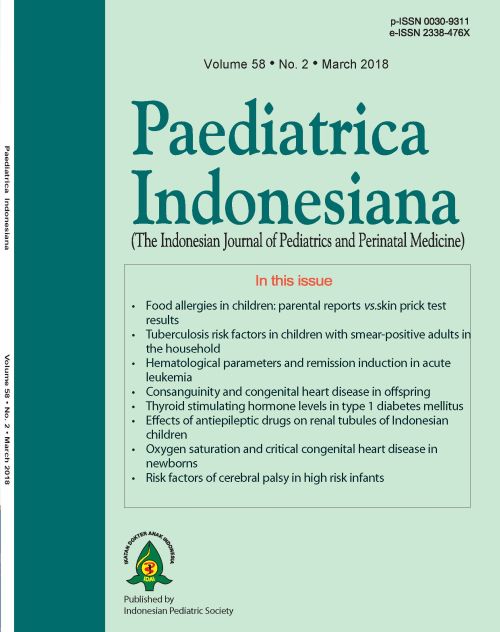Risk factors and the occurrence of cerebral palsy in high risk infants
Abstract
Background The incidence of cerebral palsy (CP) has increased due to better survival rates of high-risk babies. Early detection and time to the occurrence of CP in the first year of life is important in order to provide early intervention.
Objectives To determine the proportion of CP in high-risk babies, the time to the occurrence of CP in the first year, and assess possible associations between risk factors of CP and time to the occurrence of CP.
Methods A prospective cohort study was done on 150 high-risk babies up to the age of 12 months. We obtained history of motor ability and assessed primitive reflexes and postural reactions of subjects at the ages of 4 and 6 months. The diagnosis of CP was established at 6 and 12 months of age.
Results The proportion of CP was 26% at 6 months and 24% at 12 months of age. Significant risk factors associated with CP at 6 and 12 months of age were cerebral ultrasound abnormalities, hypoxic-ischemic encephalopathy, and intracranial hemorrhage. In 88.7% of subjects with CP, CP was detected in the first 6 months. Mean age at the occurrence of CP was 9.99 months (95%CI 9.46 to 10.53). Risk factors that significantly affected the time to the occurrence of CP by survival analysis were ultrasound abnormalities and hypoxic-ischemic encephalopathy.
Conclusions Cerebral palsy can be detected as early as the first 6 months of life. Cerebral ultrasound abnormalities and hypoxic ischemic encephalopathy are the risk factors associated with CP.
References
2. Vincer MJ, Allen AC, Joseph KS, Stinson DA, Scott H, Wood E. Increasing prevalence of cerebral palsy among very preterm infants: a population based study. Pediatrics. 2006;118:e1621-6.
3. Cooley WC, American Academy of Pediatrics Committee on Children with Disabilities. Providing a primary care medical home for children and youth with cerebral palsy. Pediatrics. 2004;114:1106-13.
4. Palmer FB. Strategies for the early diagnosis of cerebral palsy. J Pediatr. 2004;145:S8-11.
5. Zafeiriou DI, Tsikoulas IG, Kremenepoulos GM. Prospective follow-up of primitive reflex profiles in high-risk infants: clues to an early diagnosis of cerebral palsy. Pediatr Neurol. 1995;13:148-52.
6. Shapiro BK. Cerebral palsy: a reconceptualization of the spectrum. J Pediatr. 2004;145:S3-7.
7. Volpe JJ. Intracranial hemorrhage: Germinal matrix-intraventricular hemorrhage of the premature infant. In: Volpe JJ, editor. Neurology of the newborn. 5th ed. Philadelphia: Saunders Elsevier; 2008. p. 517-73.
8. Cools F, Askie LM, Offringa M. Elective high-frequency oscillatory ventilation in preterm infants with respiratory distress syndrome: an individual patient data meta-analysis. BMC Pediatrics. 2009;9:33-9.
9. Dani C, Bertini G, Pezzati M, Cecchi A, Caviglioli C, Rubaltelli FF. Early extubation and nasal continuous positive airway pressure after surfactant treatment for respiratory distress syndrome among preterm infants <30 weeks' gestation. Pediatrics. 2004;113:e560-3.
10. Ito T, Hashomoto K, Kadowaki K, Nagata N, Makio A, Takahashi H, et al. Ultrasonographic findings in the periventricular region in premature newborns with antenatal periventricular leukomalacia. J Perinat Med. 1997;25:180-3.
11. Boal DK, Watterberg KL, Miles S, Gifford KL. Optimal cost-effective timing of cranial ultrasound screening in low-birth-weight infants. Pediatr Radiol. 1995;25:425-8.
12. Pinto Martin JA, Riolo S, Cnaan A, Holzman C, Susser MW, Paneth N. Cranial ultrasound prediction of disabling and nondisabling cerebral palsy at age two in low birth weight population. Pediatrics. 1995;95:249-54.
13. Volpe JJ. Hypoxic-ischemic encephalopathy:clinical aspects. In: Volpe JJ, editor. Neurology of the newborn. 5th ed. Philadelphia: Saunders Elsevier; 2008. h. 517-73.
14. Miller SP, Ramaswamy V, Michelson D, Barkovich AJ, Holshouser B, Wycliffe N, et al. Patterns of brain injury in term neonatal encephalopathy. J Pediatr. 2005;146:453-60.
15. Accardo J, Kammann H, Hoon AH. Neuroimaging in cerebral palsy. J Pediatr. 2004;145:S19-27.
Authors who publish with this journal agree to the following terms:
Authors retain copyright and grant the journal right of first publication with the work simultaneously licensed under a Creative Commons Attribution License that allows others to share the work with an acknowledgement of the work's authorship and initial publication in this journal.
Authors are able to enter into separate, additional contractual arrangements for the non-exclusive distribution of the journal's published version of the work (e.g., post it to an institutional repository or publish it in a book), with an acknowledgement of its initial publication in this journal.
Accepted 2018-04-16
Published 2018-04-30













